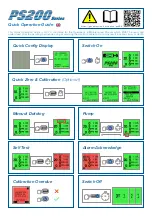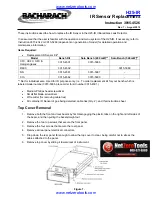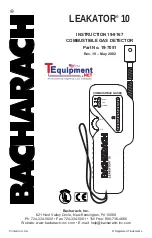
CMS-4 IN-HELMET CARBON MONOXIDE MONITOR
Page 16
© 2019 CLEMCO INDUSTRIES CORP.
www.clemcoindustries.com
Manual No. 29872
5.1
Calibration Schedule
5.1.1
Once the date and time are set, per Section 2.3,
the monitor displays a reminder that a bump test and/or
calibration are due. Factory setting are:
Bump test reminder is set for 30 days.
Calibration reminder is set for 90 days.
Initial Calibration Schedule: To become familiar with the
operation and settings of the monitor the following initial
schedule should be observed:
Do a bump test daily for the first week of operation.
Refer to Section 5.6.
Calibrate weekly for the first month of operation.
Refer to Section 5.7.
Follow bump test and calibration reminder
schedules thereafter.
Bump test before use if the monitor was out of
service for more than one week.
5.2
Performing Fresh-Air Adjustments
Fresh-air adjustments must be done in a fresh-air
environment, free of toxic or combustible gases and with
normal oxygen content (20.9%). The usual method is to
set it in fresh ambient air.
If fresh, ambient air cannot
be assured, set the fresh-air baseline with impurity-
free (0 ppm) test gas, as described in Section 5.2.2.
5.2.1 Fresh-Air Adjustment with Ambient Air
5.2.1.1
Turn ON the CMS-4 by pressing and holding the
POWER/MODE button until the alarm beeps. Allow the
monitor to finish its warm-up sequence.
5.2.1.2
Press and hold the AIR button. While pressing
the AIR button, the LCD displays
HOLD
, a prompt to
keep pressing the AIR button.
5.2.1.3
When the fresh-air baseline has been set, the
LCD displays “Adj,” and a prompt to
RELEASE
the AIR
button. The monitor beeps once and the screen displays
0 ppm, as shown in Figure 20.
Figure 20
5.2.1.4
The monitor is now in Measuring Mode (normal
operation). After an initial calibration per Section 5.7, the
CMS-4 is ready for monitoring.
5.2.2 Fresh-Air Adjustment with Impurity-Free (0
ppm CO) Test Gas
The following is required to set the fresh-air baseline
with impurity-free test gas:
Impurity-free test gas, Stock No. 11132
Calibration connector with 0.5 LPM fixed-flow slide
valve, tubing, and calibration cup.
5.2.2.1
Make sure the monitor is off.
5.2.2.2
Prepare the calibration-connector regulator
valve and impurity-free test gas, per Section 5.3.
5.2.2.3
Turn ON the CMS-4 by pressing and holding the
POWER/MODE button until the alarm beeps. Allow the
monitor to finish its warm-up sequence.
5.2.2.4
Open the connector slide valve by sliding it to
the OPEN position, away from the cylinder.
5.2.2.5
Press and hold the AIR button. While pressing
the AIR button, the LCD displays
HOLD
, a prompt to
keep pressing the AIR button.
5.2.2.6
When the fresh-air baseline has been set, the
LCD displays “Adj,” and a prompt to
RELEASE
the AIR
button. The monitor beeps once and the screen displays
0 ppm, as shown in Figure 20.
5.2.2.7
The monitor is now in Measuring Mode (normal
operation). After an initial calibration per Section 5.7, the
CMS-4 is ready for monitoring.
5.2.2.8
Close the connector slide valve by sliding it to
the CLOSE position, toward the test gas cylinder.
5.2.2.9
Remove the calibration cup by gently prying the
retaining clips off the monitor while lifting up on the cup.
Refer to Section 5.5 for additional information on
removing the calibration cup.
5.2.2.10
Unscrew the calibration connector with slide
valve from the test gas cylinder. The test gas cylinder
has a positive seal, whereas the calibration-connector
valve does not. If the connector is not removed from the
test gas cylinder, over time the cylinder will empty.
5.2.2.11
Refer to Section 5.8 for information on storing
the calibration kit and test gas.
Gas
Battery Icon
Current Gas (CO)
Concentration
Time
LCD Window
CO
0
12:34
ppm
Heart Symbol
Pulses, indicating the
monitor is in normal
operating status.









































